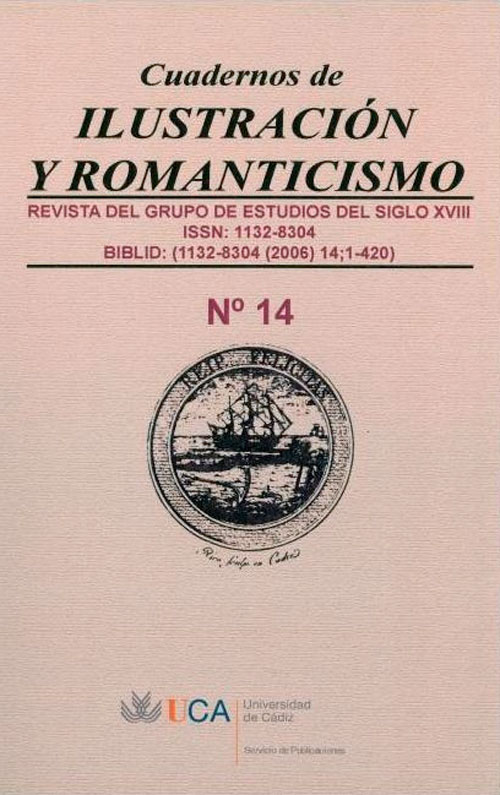Suicide in early science fiction
Abstract
The three stories analyzed in this article —Hoffmann’s The Sandman (1817), Mary Shelley’s The Mortal Immortal (1834) and Hawthorne’s Rappaccini’s Daughter (1844)— have been traditionally analyzed from the perspectives of fantastic and gothic literature. However, all three contain cognitive logic extrapolations of the scientific knowledge at the time of publication. Therefore, they comply with the requirements of science fiction and may be analyzed under the light of the science fiction reading protocol. Said perspective allows considering the improbable as literally real and makes it possible to incorporate such improbabilities into the analysis of the protagonists’ suicide projects. Additionally, the Frankenstein syndrome —according to which all scientific transgressions of natural law lead to destruction— is manifested in all three stories.
Keywords
Downloads
How to Cite
License

This work is licensed under a Creative Commons Attribution-NonCommercial-NoDerivatives 4.0 International License.
The papers published in this journal are the property of Cuadernos de Ilustración y Romanticismo: the source must be cited whenever they are used.
The authors retain the copyright © and grant the journal the right to publish. They may host their work in the final published version on personal websites or websites intended for scientific dissemination, provided that they indicate the source.
References
ALDISS, Brian W. y David Wingrove, Trillion Year Spree. The History of Science Fiction, Atheneum, New York, 1986.
ALSEN, Eberhard, «The Ambitious Experiment of Dr. Rappaccini», American Literature, vol. 43, nº 3 (Nov., 1971), pp. 430-431.
ASIMOV, Isaac, «The First Science Fiction Novel», ASIMOV on Science Fiction, Doubleday, Garden City, NY, 1981.
——, «Specialization», Isaac Asimov’s Science Fiction, (Nov., 1986), pp. 4 8.
——, (editor), Isaac Asimov Presents: The Best Science Fiction of the 19th Century, Knightsbridge, New York, 1991.
BALDICK, Chris (editor), The Oxford Book of Gothic Tales, Oxford UP, Oxford, 1992.
BENSICK, Carol Marie, La Nouvelle Beatrice: Renaissance and Romance in «Rappaccini’s Daughter», Rutgers UP, New Brunswick, NJ, 1985.
BRADBURY, Ray, Hail and Farewell, S is for Space, Bantam-Pathfinder, New York, 1972.
BRENZO, Richard, «Beatrice Rappaccini: A Victim of Male Love and Horror», American Literature, vol. 48, nº 2 (May, 1976), pp. 152-164.
CALVINO, Italo (editor), Fantastic Tales: Visionary and Everyday, Pantheon, New York, 1997.
CAMUS, Albert, Le mythe de Sisyphe, Gallimard, París, 1942.
COTTOM, Daniel, «The Work of Art in the Age of Mechanical Digestion», Representations, nº 66 (Spring, 1999), pp. 52-74.
DELANY, Samuel R, «Generic Protocols: Science Fiction and Mundane», The Technological Imagination: Theories and Fictions, eds. Teresa de Lauretis, Andreas Huyssen y Kathleen Woodward, Coda P, Madison, 1980.
Dobbs, Betty J., The Foundations of Newton’s Alchemy: or, «The Hunting of the Greene Lyon», Cambridge UP, New York, 1975.
DOUBLEDAY, Neal Frank, «Hawthorne’s Use of Three Gothic Patterns», College English, vol. 7, nº 5 (Feb., 1946), pp. 250-262.
DURKHEIM, Emile, Le suicide: Étude de sociologie, Quadrige / Presses Universitaires de France, Paris, 1983.
«Extrapolate» Random House Unabridged Dictionary, Second Edition, 1993.
HAWTHORNE, Nathaniel, Rappaccini’s Daughter, Isaac Asimov Presents: The Best Science Fiction of the 19th Century, eds. Isaac Asimov, Martin H. Greenberg y Charles G. Waugh, Knightsbride, New York, 1991.
HOEVELER, Diane Long, «Mary Shelley and Gothic Femininism: The Case of The Mortal Immortal», Iconoclastic Departures: Mary Shelley after Frankenstein: Essays in Honor of the Bicentennary of Mary Shelley’s Birth, eds. Syndy M. Conger et al, Associated UP, Cranbury, NJ, 1997.
HOFFMANN, E. T. A., The Sandman (traducción de J. T. Bealby), Isaac Asimov Presents: The Best Science Fiction of 19th Century, eds. Isaac Asimov, Martin H. Greenberg y Charles G. Waugh, Knightsbride, New York, 1991.
HOFKOSH, Sonia, «Disfiguring Economics: Mary Shelley’s Short Stories», The Other Mary Shelley: Beyond Frankenstein, eds. Audrey A. Fisch, Anne K. Mellor y Esther H. Schor, Oxford UP, New York, 1993.
HUET, Marie-Helene, «Living Images: Monstrosity and Representation», Representations, nº 4 (Fall, 1983), pp. 73-87.
JOHANSON, Donald C. y Maitland A. EDEY, Lucy: The Beginnings of Humankind, Simon & Schuster, New York, 1981.
LIEBMAN, Sheldon W., «Hawthorne and Milton: The Second Fall in Rappaccini’s Daughter», The New England Quarterly, vol. 41, nº 4 (Dec., 1968), pp. 521-535.
LOFFICIER, Jean-Marc y Randy LOFFICIER, French Science Fiction, Fantasy, Horror and Pulp Fiction: A Guide to Cinema, Television, Radio, Animation, Comic Books and Literature from the Middle Ages to the Present, McFarland, Jefferson, NC, 2000.
MALMGREN, Carl D., Worlds Apart: Narratology of Science Fiction, Indiana UP, Bloomington, 1991.
MITCHELL, Silas W., «The last of a Veteran Chess Player», The Chess Monthly: An American Chess Serial, ed. Daniel Willard Fiske, P. Miller and Son, New York, nº 1 (Feb. 1857), pp. 41-44.
NICHOLLS, Peter (editor), The Science Fiction Encyclopedia, Doubleday, Garden City, NY, 1979.
NORFORD, Don Parry, «Rappaccini’s Garden of Allegory», American Literature, vol. 50, nº 2 (May, 1978), pp. 167-186.
O’DONOHOE, Nick, «Condemned to Life: The Mortal Immortal and The Man Who Never Grew Young», Death and the Serpent: Immortality in Science Fiction and Fanstasy, eds. Carl B. Yoke y Donald M. Hassler, Greenwood Press, Westport, CT, 1985.
ORFILA, Mateo P., Traité des poisons tirés des règnes minéral, végétal et animal, ou, Toxicologie générale, considérée sous les rapports de la Physiologie, de la Pathologie et de la Médicine Légale, 2 vols., Crochard, París, 1814-1815.
PALACIO, Jean de, MARY SHELLEY dans son oeuvre, Klincksieck, París, 1969.
RABKIN, Eric S. (editor), Science Fiction: A Historical Anthology, Oxford UP, Oxford, 1983.
SHELLEY, Mary W., The Mortal Immortal, Isaac Asimov Presents: The Best Science Fiction of the 19th Century, eds. Isaac Asimov, Martin H. Greenberg y Charles G. Waugh, Knightsbride, New York, 1991.
——, Frankenstein; or, The Modern Prometheus, Simon & Schuster, New York, 2004.
SMITH, Johanna, M., Mary Shelley, Twayne-Simon & Schuster-Macmillan, New York, Prentice Hall, London, 1996.
STENDHAL, De l’amour, Garnier-Flammarion, París, 1965.
SUVIN, Darko, Metamorphoses of Science Fiction: On the Poetics and History of a Literary Genre, Yale UP, New Haven, 1979.
TATAR, Maria M., «E. T. A. Hoffmann’s Der Sandmann: Reflection and Romantic Irony», MLN, vol. 95, nº 3 (Apr., 1980), pp. 585-608.
TODOROV, Tzvetan, Introduction à la Littérature Fantastique, Seuil, París, 1970.







